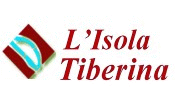Article Index
A) History and Description
B) Images![]() C) Legend
C) Legend
D) Bibliography and References
A) HISTORY AND DESCRIPTION
(The meaning of the words in italic are described in the Legend)
The Tempio dei Giovani is a small Synagogue founded by Sandro Di Castro and Semi Pavoncello and reopened to the cult in December 1985.
The Synagogue is a big room located at the second floor of the Jewish Hospital, in St Bartholomew square #24, close to the Main Temple, the Jewish Museum and the old ghetto. The Tempio dei Giovani is located in the same place where Rav Panzieri kept davening during the German occupation of Rome and the Shoa.
At first the building hosted the Poor Disables Asylum, but even then a Hazan weekly came there to hold a Minyan with the old people who cannot reach the other temples (at first the "Cinque Scole" and later the Main Temple on the Tiber left bank). But in 1937 the room officially became a Beit-haKneset and was furnished with a Teva, an Aron and some benches located in the same current positions.
In the years 1938-39 the racial laws were enacted and the discrimination of Jews began in all Country, but this did not stop the activity of the community and the religious life in the small temple.
The Rosh haShana and the Yom Kippur continued to be celebrated until 1943 when Rome was occupied by the German army. The Hazan, shofar blower, James Funaro was deported to Auschwitz together with the other Jews captured in the ghetto during the Sukkot on October 16th, while the Hazan Amadio Fatucci was killed at the Fosse Ardeatine five months later.
Although the Jews still in Rome were forced to live in hiding, the temple life, now the only Beit-haKneset remained in Rome, continued under the leadership of Rav David Panzieri. It was still active on the morning of June 5th 1944 when the American soldiers of the 5th Army entered Rome and the Jewish ones attended the blessing of the haGomel for having survived the fighting of that terrible year.
In 1970, the Asylum for the Poor and the Disabled was replaced by the Israelitic Hospital and the Beit-haKneset was restructured: there was placed the ancient old Aron from the centuries-old Scola and private donations enriched the temple of new seforim and silver ornaments.
The current name "Tempio dei Giovani" (Young People's Shul) was given by a group of young people who for some time celebrated the davening without the guidance of Rabbis or Hazanim. Thanks to them the ancient Italian minhag with the typical Roman chant has been kept as a valuable teaching and tradition for the future generations.
In the 90s of the last century the temple was adorned with stained-glass windows and a brass mechitza, both designed by Aldo Castro. The Tempio dei Giovani became a welcoming place for the celebration of Bar/Bat Mitzvah and weddings, and every Shabbat a tasty Kiddush is offered to members and visitors from all over the world.
B) IMAGES
|
1 |
 6 |
 7 |
|
C) LEGEND
| Aron haQodesh | or simply Aron is an ornate cabinet that enshrines the sacred Torah scrolls |
| Bar/Bat Mitzwah | According to Jewish law a boy/girl at the age of thirteen years become a Bar/Bat Mitzvah and is responsible for his/her behaviour |
| Beit-haKneset | Synagogue. Place of meeting, study and prayer, also called "scola", where are kept the manuscript scrolls of the Torah |
| Davening | The prayer recitation that forms part of the observance of Judaism |
| Dvar Torah | Word of Torah |
| haGomel | Thanking God for Deliverance |
| Hanukka | Festival of Lights, Feast of Dedication, observed by kindling the menorah |
| Hazan | A cantor of a Synagogue |
| Kiddush | Blessing of the wine with which it is used to sanctify the Jewish festivals |
| Mechitza | A separé, in particular the one used to separate men from women |
| Menorah | The nine-branched candelabrum |
| Minhag | A type of liturgical rite, which denotes a set of liturgies, traditions, rules specific to certain communities of rabbinic Judaism of the Diaspora |
| Minyan | The number ten males over the age of thirteen needed for public prayer and the public reading of the Torah |
| Rav | Title attributed to many Orthodox rabbis |
| Rosh haShana | New Year's Beginning. Its celebration is characterized by the blowing of the shofar |
| Seforim | Testo giudaico |
| Shabbat | Saturday, the most important Jewish celebration, as it reminds the rest of the Lord after the creation |
| Shofar | A ram horn that is blown on Rosh ha-Shanah and at the conclusion of Yom Kippur |
| Sukkot | Eight-day festival of the pilgrimage that begins just five days after Yom Kippur |
| Tefilla | The declaration of feelings and desires that every Jew makes turned to God |
| Teva | Sort of table at which the officiant recites the prayers in the synagogue |
| Torah | The first five books of the Tanakh, also known by the Greek name of Pentateuch |
| Yom Kippur | Jewish religious Feast which celebrates the day of the expiation |
D) BIBLIOGRAPHY AND REFERENCES
1- TdG Tempio dei Giovani - Roma Link
2- Moked - il portale dell'ebraismo italiano Link
All the images are published by courtesy of the "Tempio dei Giovani"









